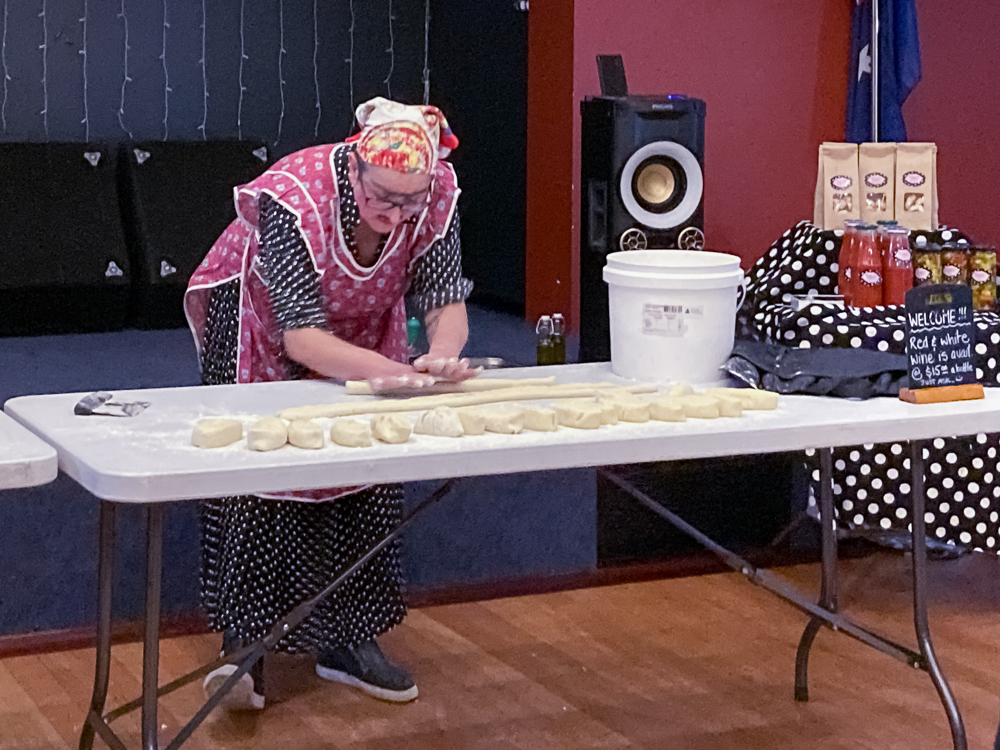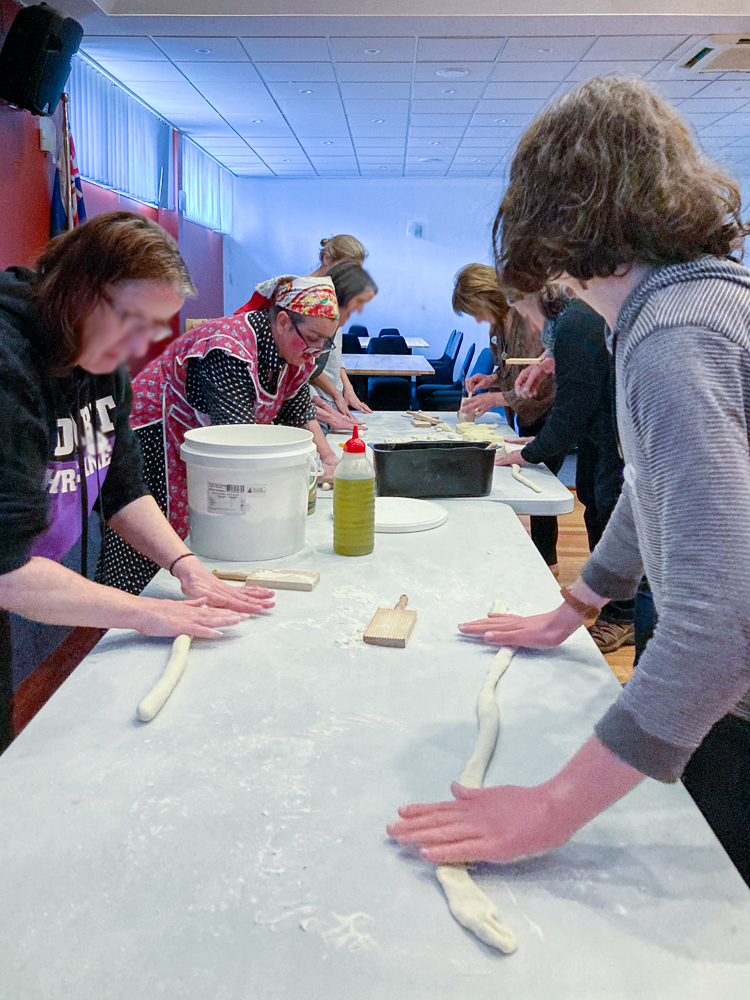Week 39/2021: gnocchi revisited
Week 39: Week of 27 September 2021
21 for 2021 update
Vegetable of the week (thing 2)
Thing 2 is to choose a different vegetable every week from Alice Zaslavsky’s book In Praise of Veg and make a recipe from the book using that vegetable.
Remember a few weeks ago, I tried the gnocchi recipe and it wasn’t super successful? One of my lovely online friends read about my attempt and suggested that I look into Mamma Rosa’s MastaPasta classes.
I investigated and discovered that Rose is a well-known foodie and funny lady, who is amazing and is incredibly brave to boot. She holds Mamma Rosa’s MastaPasta classes, a fabulous mix of cooking, singing, dinner and stories, every Sunday at the Italian Club.
I asked Kramstable if he’d be interested in going to learn to make gnocchi instead of our traditional Sunday mac and cheese night. He was, so I booked us in. Exciting!
When we arrived, we met Mamma Rosa’s assistant, Mamma Maria, who invited us to take a seat at one of the tables. Gradually, the rest of the class assembled to wait for Mamma Rosa to appear. After her spectacular entrance, Mamma Rosa told us we’d be having a three-course meal, starting with bruschetta, then our gnocchi with a napoli sauce, and a dessert of red-wine poached pear with her family’s custard recipe.
Let me just say up-front that I do not speak Italian. I tried it on Duolingo thinking that, because I knew French, I’d have less trouble picking it up. Wrong! I was a major dunce at it. Kramstable, on the other hand, did learn it in school so he knows it better than I do. But as a result of my terrible language skills, I have to confess I’m one of those Australians who pronounced bruschetta as “bruss-shet-tta” and now I have been firmly corrected and I will never say it like that again. I promise!
Kramstable and I stripped the leaves off the basil, while some of the others chopped up the tomatoes. Mamma Rosa explained the best way to prepare the toasted bread is to rub a clove of garlic over the surface, drizzle it with olive oil and then pile on the tomato and basil mix, her pickled veggies and, of course, the bocconcini. Super easy to make, super yummy, impossible to eat without making a mess!

Mamma Rosa had already cooked the potatoes for the gnocchi, about a million of them, I think, and she got to work mashing them with the potato ricer. I must have one of these!
One potato per person, one egg to bind the lot and flour, one cup per potato (but this depends of the size of the potato and the size of the cup). It doesn’t matter what flour you use. Apparently (I had no idea), if you see zeroes on flour that will tell you how many times it’s been sifted. Two zeros, two siftings. Three zeros three siftings and a finer flour. She says it matters for pizza, but for gnocchi, it does not.

Someone asked about using pumpkin. Mamma Rosa said you can, but it’s a lot wetter than potato so you need more flour. She suggested getting it right with potatoes first before trying it with other things.
Once the dough was done (not sticky), it was time to roll it into long strands and cut up the little gnocchi and roll them into shape.

Once I got the hang of that, it was the most soothing thing I’d done all week.

In the kitchen, we saw the poached pears and custard that were both underway, and Mamma Rosa started on the napoli sauce. She explained there were many varieties of this, depending on where in Italy you’re from. Her version doesn’t have onions, for example, but others will. She uses “a drop” of olive oil, smashes up some garlic cloves and throws them in, skin and all, and once they’re sizzling, adds the passata and the other ingredients, including the expertly stripped basil. Cue a wonderful story about making passata with her family as a child.

And that’s it. The gnocchi are done when they rise to the top of the water, and you sit them there for a few extra minutes before taking them out and serving with the sauce.
Ideally, they’ll all be around the same size . . . .
Served with parmigiana-reggiano cheese, the gnocchi were yummy. Delicate and lovely and very light. Definitely one to try at home.
And then, Mamma Rosa’s final performance, before Maria brought out the desserts. I don’t like pears. I actually don’t like fruit, but that’s another story. If you’d told me I’d eat an entire half pear for dessert, I’d never have believed you. Yet here I was with a alcohol-poached pear, sitting on a bed of sensational looking custard and some red wine sauce. It was delicious. The super sweetness of the custard was beautifully toned down by the red wine and the whole dish was elegant and balanced.

It was a super fun night. I’m glad we went and I’m inspired to give gnocchi making another go. Mamma Rosa suggested that it would take three attempts before you got it right, so it looks like some more experimenting is on the cards. After my trip to the catering supply store.
If you’re in Hobart and have a free Sunday evening coming up, you need to go to a MastaPasta class! It’s fun and you’ll learn heaps. You can book here.
There was no veggie cooking this week. I’m still working my way through that unusual ingredient list.
Kramstable’s videos (thing 8)
I did a bit of work on this. It’s coming together well, I think.
My mother’s story (thing 9)
I asked my mother some questions she didn’t want to answer this week so we didn’t get very far. I’m at the point where I think I just need to start writing and see what happens. That was the advice from Patti Miller in the second week of my Life Writing course. She says it’s best to just start writing rather than have too much of a plan about what it’s going to look like, because the joy of doing this work comes from the discovery and the learning that you do as you write.
I’m so grateful to have had the opportunity to do this course. I learned a lot and have come away from it with a renewed passion for my writing. I don’t want to do anything else.
As I’ve explored this work, and am working through the photography courses I’ve been doing, I’m noticing the same things resonate with me in both. For me, they’re two sides of the same coin, and I want to use both of them as tools to explore the same things. I could write a massive dissertation on this but I won’t. I’m just finding it so exciting to find the same themes in both crafts and that doing them both is fulfilling the same need in me, but in different ways.
Brainsparker (thing 17)
Because the next module isn’t available until the end of October, I have some time to play around with the Brainsparker gym* innovator play book from module 9.
One of the activities is to set out how you’ll build “incubation time” into your daily life. That reminded me of Spacemaker and the stuff I’m supposed to be doing on that, so I pulled that material out to refresh my memory on what I said I’d do. It was a good reminder to keep those practices at the front of my mind as I’d let them slide a bit.
21 for 2021 summary
- Things completed this week: 0
- Things completed to date: 4 (1, 11, 18, 20)
- Things I progressed: 3 (8, 9, 17)
- Things in progress I didn’t progress: 9 (2, 4, 5, 6, 7, 10, 13, 14, 16)
- Things not started: 5 (3, 12, 15, 19, 21)
The rest of the week

What did I learn this week?
I learned from Elizabeth Gilbert’s book Eat, Pray, Love that the Italian language was developed very differently to other European languages. While many of them are what they are because they were the dialect spoken in the dominant city of the country, there was no dominant city in Italy. Italy was made up of bits of other countries and various regions, and only became the country we know in 1861. So there was no “Italian” language and none of the dialects could be understood by speakers of any of the other dialects.
A bunch of intellectuals decided that there needed to be a single official language for the country so they picked the dialect they considered the most beautiful, and that became Italian. The dialect that they chose was that of Dante, the 14th Century Florentine poet. Liz Gilbert says that this was basically equivalent to a bunch of Oxford dons deciding that Shakespearean English would be what everyone in England would speak.
Amazing.
What was the best thing about this week?
Number 1: Finding out that the skin thing my doctor removed last week for a biopsy was not a skin cancer.
Number 2: Doing the life writing course.
Number 3: The gnocchi class.
What I’m reading this week
- Mindfulness-Integrated CBT for Well-Being and Personal Growth by Bruno A. Cayoun
- The Most Beautiful Walk in the World by John Baxter
- Effortless by Greg McKeown
- Eat, Pray, Love by Elizabeth Gilbert
Habit tracker
- Days I went for a walk in the morning (Goal = 5): 7
- Days I did my morning planning routine at work (Goal = 5): 0
- Days I did my post-work pack up routine (Goal = 5): 0
- Days I worked on my art (Goal = 2): 1
- Days I read a book (Goal = 7): 7
- Days I did yoga stretches (Goal = 7): 0
- Days I had a lunch break away from my desk (Goal = 5 work days): 5
- Days I went for a walk or did other physical activity in the afternoon (Goal = 5): 4
- Days I shut my computer down before 9.30 (Goal = 6): 7